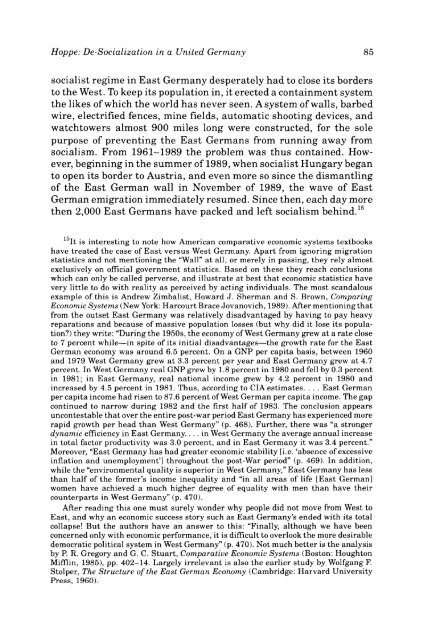Review of Austrian Economics - The Ludwig von Mises Institute
Review of Austrian Economics - The Ludwig von Mises Institute
Review of Austrian Economics - The Ludwig von Mises Institute
You also want an ePaper? Increase the reach of your titles
YUMPU automatically turns print PDFs into web optimized ePapers that Google loves.
Hoppe: De-Socialization in a United Germany 85<br />
socialist regime in East Germany desperately had to close its borders<br />
to the West. To keep its population in, it erected a containment system<br />
the likes <strong>of</strong> which the world has never seen. A system <strong>of</strong> walls, barbed<br />
wire, electrified fences, mine fields, automatic shooting devices, and<br />
watchtowers almost 900 miles long were constructed, for the sole<br />
purpose <strong>of</strong> preventing the East Germans from running away from<br />
socialism. From 1961-1989 the problem was thus contained. However,<br />
beginning in the summer <strong>of</strong> 1989, when socialist Hungary began<br />
to open its border to Austria, and even more so since the dismantling<br />
<strong>of</strong> the East German wall in November <strong>of</strong> 1989, the wave <strong>of</strong> East<br />
German emigration immediately resumed. Since then, each day more<br />
then 2,000 East Germans have packed and left socialism behind. 15<br />
15 It is interesting to note how American comparative economic systems textbooks<br />
have treated the case <strong>of</strong> East versus West Germany. Apart from ignoring migration<br />
statistics and not mentioning the "Wall" at all, or merely in passing, they rely almost<br />
exclusively on <strong>of</strong>ficial government statistics. Based on these they reach conclusions<br />
which can only be called perverse, and illustrate at best that economic statistics have<br />
very little to do with reality as perceived by acting individuals. <strong>The</strong> most scandalous<br />
example <strong>of</strong> this is Andrew Zimbalist, Howard J. Sherman and S. Brown, Comparing<br />
Economic Systems (New York: Harcourt Brace Jovanovich, 1989). After mentioning that<br />
from the outset East Germany was relatively disadvantaged by having to pay heavy<br />
reparations and because <strong>of</strong> massive population losses (but why did it lose its population?)<br />
they write: "During the 1950s, the economy <strong>of</strong> West Germany grew at a rate close<br />
to 7 percent while—in spite <strong>of</strong> its initial disadvantages—the growth rate for the East<br />
German economy was around 6.5 percent. On a GNP per capita basis, between 1960<br />
and 1979 West Germany grew at 3.3 percent per year and East Germany grew at 4.7<br />
percent. In West Germany real GNP grew by 1.8 percent in 1980 and fell by 0.3 percent<br />
in 1981; in East Germany, real national income grew by 4.2 percent in 1980 and<br />
increased by 4.5 percent in 1981. Thus, according to CIA estimates. . . . East German<br />
per capita income had risen to 87.6 percent <strong>of</strong> West German per capita income. <strong>The</strong> gap<br />
continued to narrow during 1982 and the first half <strong>of</strong> 1983. <strong>The</strong> conclusion appears<br />
uncontestable that over the entire post-war period East Germany has experienced more<br />
rapid growth per head than West Germany" (p. 468). Further, there was "a stronger<br />
dynamic efficiency in East Germany. ... in West Germany the average annual increase<br />
in total factor productivity was 3.0 percent, and in East Germany it was 3.4 percent."<br />
Moreover, "East Germany has had greater economic stability [i.e. 'absence <strong>of</strong> excessive<br />
inflation and unemployment'] throughout the post-War period" (p. 469). In addition,<br />
while the "environmental quality is superior in West Germany," East Germany has less<br />
than half <strong>of</strong> the former's income inequality and "in all areas <strong>of</strong> life [East German]<br />
women have achieved a much higher degree <strong>of</strong> equality with men than have their<br />
counterparts in West Germany" (p. 470).<br />
After reading this one must surely wonder why people did not move from West to<br />
East, and why an economic success story such as East Germany's ended with its total<br />
collapse! But the authors have an answer to this: "Finally, although we have been<br />
concerned only with economic performance, it is difficult to overlook the more desirable<br />
democratic political system in West Germany" (p. 470). Not much better is the analysis<br />
by P. R. Gregory and G. C. Stuart, Comparative Economic Systems (Boston: Houghton<br />
Mifflin, 1985), pp. 402-14. Largely irrelevant is also the earlier study by Wolfgang F.<br />
Stolper, <strong>The</strong> Structure <strong>of</strong> the East German Economy (Cambridge: Harvard University<br />
Press, 1960).

















